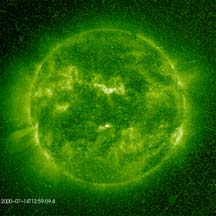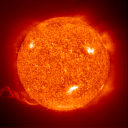| ionosphere | propagation | radio blackouts | sunspot cycle | smoothed sunspot numbers | solar flares |
| coronal mass ejections | solar flux | smoothed solar flux numbers | daily reports | wwv |
Frequently Asked Questions about Solar Indices

|
What is the wavelength of the energy? The Sun generates electromagnetic radiation at various wavelengths, which ionize particular regions:
- hard X-rays (1-10 Angstroms) ionizes the D region,
- soft X-rays (10-100 Angstroms) ionizes the E region,
- ultraviolet light (100-1000 Angstroms) ionizes the F region.
How does it affect Earth? The Sun's solar wind hits and travels along Earth's magnetic field. The impact compresses Earth's magnetic field on the side facing the Sun and pushes it out on the side away from the Sun. The part stretching out away from the Sun is Earth's magnetotail. It extends downwind a great distance, equal to tens of times the radius of Earth. The electromagnetic radiation from the Sun affects Earth's entire ionosphere in daylight. Charged particles ejected by the Sun are guided along Earth's magnetic field lines into the planet's ionosphere and thus only impact high latitudes where the magnetic field lines go into Earth.
How do we measure Earth's varying magnetic field? Variations in Earth's magnetic field are measured by magnetometers. Data from two measurements are readily available from the government -- the daily A index and the three-hour K index:
- the daily A index has a linear scale from 0 (quiet) to 400 (severe storm),
- the three-hour K index has a quasi-logarithmic scale from 0 to 9, a compressed version of the A index, with 0 being quiet and 9 being severe storm.
Just before, during, and just after the peak of a Sunspot Cycle, the increased number of sunspots sends more ultraviolet radiation to impact Earth's ionosphere. This results in much greater ionization of the F region of Earth's atmosphere. That allows the ionosphere to refract higher radio frequencies back to Earth.
On the other hand, around the minimum time of a Sunspot Cycle, the number of sunspots is so low that higher frequencies generated on the surface of Earth travelk up and pass right on through Earth's ionosphere into outer space. That is, there is less absorption and a more stable ionosphere, resulting in the best propagation on lower frequencies.
- high SSNs are best for high frequency propagation,
- low SSNs are best for low frequency propagation.
 A smoother plot is desired by researchers. To get that, they choose a more averaged, or smoothed, measurement to measure solar cycles. This is the so-called Smoothed Sunspot number (SSN) calculated across five and a half months of data before and after a desired month, plus the data for the desired month. The amount of smoothing leaves the official SSN a half year behind the current month.
A smoother plot is desired by researchers. To get that, they choose a more averaged, or smoothed, measurement to measure solar cycles. This is the so-called Smoothed Sunspot number (SSN) calculated across five and a half months of data before and after a desired month, plus the data for the desired month. The amount of smoothing leaves the official SSN a half year behind the current month.
What are solar flares? Most of the disturbances to radio signal propagation on Earth come from solar flares and coronal mass ejections (CMEs) from the Sun. For instance, x-ray flares affect our radio propagation. Their wavelength ranges from 1 - 8 Angstroms. X-ray flares are classified as:
- C class, the smallest, usually have a minimal impact on propagation.
- M class, medium size, have a progressively adverse impact to propagation. Their electromagnetic radiation can cause the loss of all propagation on the Sunlit side of Earth due to increased absorption in the D region of the planet's atmosphere.
- X class, the biggest, also have a progressively adverse impact. Their electromagnetic radiation also can cause the loss of all propagation on the Sunlit side of Earth. Big X class flares can emit very energetic protons that are guided into Earth's polar cap by the our planet's magnetic field. That brings on a polar cap absorption event (PCA), with high D region absorption along radio signal paths passing over the polar areas of the Earth.
What causes radio blackouts? Scientists wonder about the relationship between solar flares and CMEs. They are known to happen together or separately. The time to affect Earth differs. The electromagnetic radiation from a big solar flare, traveling at the speed of light, can cause short radio blackouts on the Sunlit side of the Earth within about 10 minutes of the eruption on the Sun. On the other hand, the energetic particles ejected by a solar flare and the shock wave from a CME can take four days to arrive at Earth and disrupt propagation.
Who warns us of solar activity? Each day the U.S. government's National Oceanographic and Atmospheric Administration (NOAA) and the U.S. Air Force publish a Report on Solar and Geophysical Activity (RSGA). These reports can be found at www.sec.noaa.gov/ftpdir/forecasts/RSGA.
- Part 1
- analysis of solar activity including flares and CMEs
- forecast of solar activity
- Part 2
- summary of geophysical activity
- forecast of geophysical activity
- Part 3
- probabilities of flare and CME events -- normal propagation with no disturbances occurs when no x-ray flares higher than class C are reported or forecast, along with solar wind speeds due to coronal mass ejections around average speed
- Part 4
- observed and predicted 10.7 cm solar flux -- daily solar flux has little to do with what the ionosphere is doing on that day
- Part 5
- observed and predicted A indices
- Part 6
- geomagnetic activity probabilities -- good radio signal propagation is expected when the daily A index iforecast is at or below 15 and the K index is forecast to be 3 or below
At 18 minutes past each hour, WWV broadcasts a short version of the report covering the previous day's 10.7 cm solar flux and A index, as well as the current three-hour K index. Current solar and geomagnetic field activity and forecasts are broadcast. Normal propagation with no disturbances is expected when solar activity is low and the geomagnetic field is quiet. Low solar activity means the Sun has not produced any major flares or CMEs in the recent time period.
What is the ionosphere? The ionosphere is part of Earth's upper atmosphere where free electrons occur in sufficient density to have an influence on the propagation of radio frequency electromagnetic waves. Its ionization depends for the most part on activity on the Sun. Its density varies according to the sunspot cycle, the season, and global locations -- polar, auroral zones, mid-latitudes, and equatorial regions. Most of its ionization is produced by x-ray and ultraviolet radiation from the Sun. As Earth rotates, ionization increases in the sunlit atmosphere and decreases on the shadowed side.
To predict radio signal propagation, researchers have looked for a relationship between sunspots and the ionosphere. The best correlation at this time is the SSN and average monthly ionospheric conditions. Propagation prediction programs are based on that relationship. MUF and signal strength predictions are probabilities and not absolutes.
What is solar flux? Since they are counted when seen, sunspots are a subjective measurement. To have a more objective measurement of the Sun's output, scientists use the 10.7 cm solar flux -- a general measurement of the activity of the Sun. The 10.7 cm solar flux doesn't describe the formation of the ionosphere, because energy at a wavelength of 10.7 cm is insufficient to cause ionization. The useful correlation is between the smoothed 10.7 cm solar flux and the smoothed sunspot number. Smoothed numbers are used as correlating daily values or monthly averages is not useful.
What is meant by smoothed solar flux numbers? Propagation prediction programs correlate the SSN and smoothed 10.7 cm solar flux. The ionosphere does not react to daily variations of the Sun so the daily or weekly 10.7 cm solar flux and the daily sunspot number are not useful.